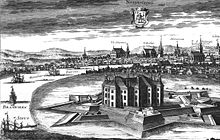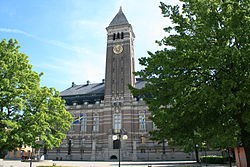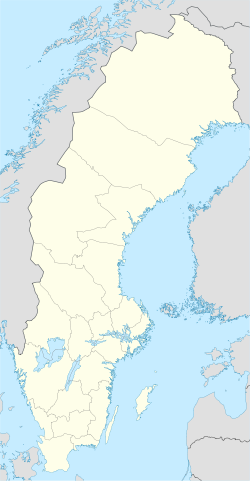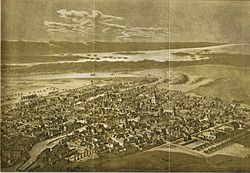- Norrköping
-
Norrköping City hall of Norrköping Nickname(s): Peking, Little Manchester Coordinates: 58°36′N 16°12′E / 58.6°N 16.2°ECoordinates: 58°36′N 16°12′E / 58.6°N 16.2°E Country Sweden Province Östergötland County Östergötland County Municipality Norrköping Municipality Area[1] – Total 35.68 km2 (13.8 sq mi) Population (2010-12-31)[1] – Total 87,247 – Density 2,446/km2 (6,335.1/sq mi) Time zone CET (UTC+1) – Summer (DST) CEST (UTC+2) Website norrkoping.se Norrköping [ˈnɔrːˈɕøːpɪŋ] is a city in the province of Östergötland in eastern Sweden and the seat of Norrköping Municipality, Östergötland County. The city has a population of 87,247 inhabitants in 2010,[1] out of a municipal total of 130,050,[2] making it Sweden's tenth largest city and eighth largest municipality.
The city is situated by the mouth of the river Motala ström, at Bråviken, an inlet of the Baltic Sea. Water power from the Motala ström and the good harbour were factors that facilitated the rapid growth of this once industrial city, known for its textile industry. It has several nicknames such as: "Sweden's Manchester", "Peking" and "Surbullestan" (Surbulle [sour bun] was a local nickname for the textile workers, and stan is short for Staden, which means The City or The Town in Swedish)
Contents
History
 Norrköping depicted as a star fort before it was burnt in 1719. Contemporary engraving by Jan van den Aveelen.
Norrköping depicted as a star fort before it was burnt in 1719. Contemporary engraving by Jan van den Aveelen.
The city has medieval foundations by settlers around the Norrköping twin city with Linköping Motala stream estuary, who used the falls and rapids to power their mills. The stream was also full of fish such as salmon. Exact dates are uncertain, but there are mentions of a church in the 12th century. It was dedicated to Saint Olaf, Norway's patron.
The first trace of the city's name is from 1283, when wealthy David Appelgren - [Lord of Östergötland] - donated his rights of salmon fishing to the Skänninge monastery. The town is estimated to have received city status in the early 14th century, although no written documents exist prior to a document from 1384. This document, signed by Albrekt of Sweden is stored in the city archive today. Köping means there was a market there.
The city was the location of several battles in the ensuing centuries. As a consequence, nothing of the medieval Norrköping remains today. During the Northern Seven Years' War (1563–1570), the entire southern part of Norrköping was burnt. It was rebuilt by John III of Sweden, who designed the current street pattern.
In 1618, a weapon industry was established by supervision of Gustavus Adolphus. The harbour also attracted ships due to its proximity to the industries of Finspång. In addition to the weapon industry, a large scale industry of textile was also initiated. An important benefactor was the industrial man Louis De Geer (1587-1652). At De Geer's death, Norrköping had 6,000 inhabitants and was Sweden's second largest city.
The city again burnt in 1655, and again in 1719 during the Great Northern War when the Russians burnt it to the ground. Stones from the Johannisborg castle were used to build new houses, and today only a few stones remain.
During the 18th century it was rebuilt and several industries soon got a stronghold: In the 1740s, Norrköping boosted three sugar refineries; in the 1750s the large scale influential snus industry was established. From this time stems the city churches of Saint Olof and Saint Hedvig, and several other old houses.
Norrköping's importance again flourished. In 1769 the Swedish Riksdag assembled there. In 1800 the king Gustav IV of Sweden was crowned in the Church of Saint Olof.
The city again suffered fires in 1822 and 1826. Thereafter wooden houses were banned. In 1841 a ship industry was initiated as a branch of Motala Verkstad in Motala. In 1850 the industry had over 600 employees making it Sweden's largest ship industry at the time. During the remaining 19th century, the industries kept expanding. The area by the Motala Stream was developed further with the construction of a cotton refinery, and a paper mill was constructed in 1854, specializing in newspaper, and is still today exporting to customers around the world.
The industry, including textile manufacturers, also expanded into the 20th century. In 1950 a total of 54 factories had 6,600 employees in town. By 1956, however, 18 of them had been closed due to competition from countries abroad with lower wages, such as Italy and Japan. In 1970 only 10 factories and 1,200 employees remained. In that year, the renowned Holmen paper mill, with its 350 years long history, announced closure, and another 900 people were let go[citation needed]. To counter the effects, several governmental authorities were relocated to Norrköping from Stockholm. See also Braviken Paper Mill.
As of 2002, Norrköping is now seeing a revival, as a center of culture and education. The Norrköping symbol represents the "new" Norrköping.
Main sights
The Motala ström river flows through the city has a parade annexed. In connection to the latter is the industrial landscape where the old textile industries once where situated.[3]
In the summer, there is a cactus plantation in Carl Johans Park. 25,000 cactuses are planted there every summer.[4]
Kolmårdens Djurpark is a zoo located 30 km north of Norrköping. In connection to the large outdoor zoo, there is also Tropicariet, an aquarium, where for example snakes, crocodiles and sharks can be seen.[5]
The archipelagos 50 km away from Norrköping are called St Anna and Gryt.[6]
A campus of Linköping University, its own symphonic orchestra, an airport called Kungsängen with 170,000 traveling (2006), a high-tech industry park called Norrköping Science Park,[7] and Petroglyphs from the Nordic Bronze Age.
Notable natives
- Hannes Alfvén - physicist, Nobel Prize winner
- Moa Martinson - author
- Laakso - music group
- Michael B. Tretow - producer and audio engineer
- Ture Nerman - poet and socialist politician
- Peter Harryson - actor, entertainer
- Pernilla Wiberg - alpine skier, double Olympic gold medalist
- Slagsmålsklubben - electronic popgroup
- Malin Baryard - horse rider
- Eldkvarn - music group
- Marduk - music group
- Amy Diamond - singer
- 23 Till - music group
- Elin Grindemyr - model
- Magnus Pääjärvi-Svensson - NHL hockey player
- John Karlsson - Musician (Current rhythm guitarist for the Canadian Band The Regal Beagle Band)
Sports
- IFK Norrköping (Association football)
- Assyriska Föreningen i Norrköping (Association football)
- Azech SF (Association football)
- Chile Unido IF (Association football)
- Eneby BK (Association football)
- Hagahöjdens BK (Association football)
- Lindö FF (Association football)
- Norrköpings IF Bosna (Association football)
- Syrianska KF (Association football)
- Norrköping Dolphins (Basketball)
- HC Vita Hästen (Ice hockey)
- Vargarna (Speedway)
- Norrköpings KK (Swimming)
- Norrköpings Rugby Klubb NRK Trojan (Rugby)
Government and infrastructure
The Swedish Transport Agency has its headquarters in Norrköping.[8] When the Civil Aviation Administration existed, its head office was in Norrköping.[9] Norrköping is one of two Swedish cities (the other being Gothenburg) that retained its tram system after the 1967 conversion to right-hand drive, see Norrköping Tramway.
References
- ^ a b c "Tätorter 2010" (in Swedish with English summary) (pdf). Statistics Sweden. http://www.scb.se/statistik/MI/MI0810/2010A01/MI0810_2010A01_SM_MI38SM1101.pdf. Retrieved 2011-09-26.
- ^ Folkmängd i Norrköpings kommun den 31 december 2010
- ^ http://www.upplev.norrkoping.se/attgora.asp/id/6040/lid/70499
- ^ http://www.upplev.norrkoping.se/attgora.asp/id/604025/lid/69094
- ^ http://www.kolmarden.com/
- ^ http://www.upplev.norrkoping.se/Sk%E4rg%E5rd%5F2__1033.html
- ^ For Sweden's planners, visualization's the real deal - EE Times, 12/03/2007. Accessed 2009-08-09
- ^ "Adresser till våra kontor." Swedish Transport Agency. Retrieved on 7 December 2010. "Huvudkontor Transportstyrelsen 601 73 Norrköping Besöksadress: Vikboplan 7, Norrköping Öppettider: Vardagar 08.00–16.30"
- ^ "Contact." Civil Aviation Administration. 16 June 2010. Retrieved on 6 December 2010. "Swedish Civil Aviation Administration S-601 79 Norrköping."
External links
- Official website (English) (Swedish)
- Norrköping Tourism (Swedish)
- Local event guide for Norrköping

Norrköping is one of 133 places with the historical city status in Sweden. Localities in Norrköping Municipality, Östergötland County, Sweden Localities: Municipalities 
Municipal seats 30 most populous cities of Sweden 7. Linköping 97,400 8. Helsingborg 91,500 9. Jönköping 84,400 10. Norrköping 83,600 11. Lund 76,200 12. Umeå 75,600 13. Gävle 68,700 14. Borås 63,400 15. Södertälje 60,300 16. Eskilstuna 60,200 17. Täby 58,600 18. Karlstad 58,500 50 most populous urban areas in the Nordic countries 1.  Stockholm
Stockholm1,372,565 2.  Copenhagen
Copenhagen1,199,224 3.  Helsinki
Helsinki1,029,773 4.  Oslo
Oslo907,288 5.  Gothenburg
Gothenburg549,839 6.  Malmö
Malmö280,415 7.  Aarhus
Aarhus249,709 8.  Turku
Turku236,226 9.  Bergen
Bergen234,800 10.  Stavanger
Stavanger221,616 31.  Lund
Lund82,800 32.  Umeå
Umeå79,594 33.  Pori
Pori76,562 34.  Joensuu
Joensuu72,167 35.  Esbjerg
Esbjerg71,576 36.  Gävle
Gävle71,033 37.  Lappeenranta
Lappeenranta70,210 38.  Kristiansand
Kristiansand67,547 39.  Tromsø
Tromsø66,669 40.  Borås
Borås66,273 41.  Hämeenlinna
Hämeenlinna66,257 42.  Eskilstuna
Eskilstuna64,679 43.  Södertälje
Södertälje64,619 44.  Karlstad
Karlstad61,685 45.  Täby
Täby61,272 46.  Randers
Randers60,656 47.  Rovaniemi
Rovaniemi59,274 48.  Vaasa
Vaasa58,607 49.  Halmstad
Halmstad58,577 50.  Kolding
Kolding57,197 Categories:- Cities in Sweden
- Norrköping
- Municipal seats of Östergötland County
- Swedish municipal seats
- Populated places in Östergötland County
- Port cities and towns of the Baltic Sea
- Market towns in Sweden
Wikimedia Foundation. 2010.





